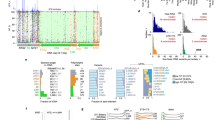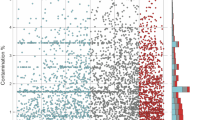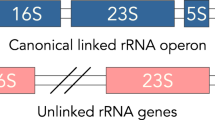Abstract
The potential for rapid reproduction is a hallmark of microbial life, but microbes in nature must also survive and compete when growth is constrained by resource availability. Successful reproduction requires different strategies when resources are scarce and when they are abundant1,2, but a systematic framework for predicting these reproductive strategies in bacteria has not been available. Here, we show that the number of ribosomal RNA operons (rrn) in bacterial genomes predicts two important components of reproduction—growth rate and growth efficiency—which are favoured under contrasting regimes of resource availability3,4. We find that the maximum reproductive rate of bacteria doubles with a doubling of rrn copy number, and the efficiency of carbon use is inversely related to maximal growth rate and rrn copy number. We also identify a feasible explanation for these patterns: the rate and yield of protein synthesis mirror the overall pattern in maximum growth rate and growth efficiency. Furthermore, comparative analysis of genomes from 1,167 bacterial species reveals that rrn copy number predicts traits associated with resource availability, including chemotaxis and genome streamlining. Genome-wide patterns of orthologous gene content covary with rrn copy number, suggesting convergent evolution in response to resource availability. Our findings imply that basic cellular processes adapt in contrasting ways to long-term differences in resource availability. They also establish a basis for predicting changes in bacterial community composition in response to resource perturbations using rrn copy number measurements5 or inferences6,7.
This is a preview of subscription content, access via your institution
Access options
Subscribe to this journal
Receive 12 digital issues and online access to articles
$119.00 per year
only $9.92 per issue
Buy this article
- Purchase on Springer Link
- Instant access to full article PDF
Prices may be subject to local taxes which are calculated during checkout



Similar content being viewed by others
References
Lauro, F. et al. The genomic basis of trophic strategy in marine bacteria. Proc. Natl Acad. Sci. USA 106, 15527–15533 (2009).
Roller, B. R. K. & Schmidt, T. M. The physiology and ecological implications of efficient growth. ISME J. 9, 1481–1487 (2015).
Pfeiffer, T., Schuster, S. & Bonhoeffer, S. Cooperation and competition in the evolution of ATP-producing pathways. Science 292, 504–507 (2001).
Bachmann, H. et al. Availability of public goods shapes the evolution of competing metabolic strategies. Proc. Natl Acad. Sci. USA 110, 14302–14307 (2013).
Stoddard, S. F., Smith, B. J., Hein, R., Roller, B. R. K. & Schmidt, T. M. rrnDB: improved tools for interpreting rRNA gene abundance in Bacteria and Archaea and a new foundation for future development. Nucleic Acids Res. 43, D593–D598 (2015).
Kembel, S. W., Wu, M., Eisen, J. A. & Green, J. L. Incorporating 16S gene copy number information improves estimates of microbial diversity and abundance. PLoS Comput. Biol. 8, e1002743 (2012).
Angly, F. E. et al. CopyRighter: a rapid tool for improving the accuracy of microbial community profiles through lineage-specific gene copy number correction. Microbiome 2, 1–13 (2014).
Klappenbach, J. A., Dunbar, J. M. & Schmidt, T. M. rRNA operon copy number reflects ecological strategies of bacteria. Appl. Environ. Microbiol. 66, 1328–1333 (2000).
Stevenson, B. S. & Schmidt, T. M. Life history implications of rRNA gene copy number in Escherichia coli. Appl. Environ. Microbiol. 70, 6670–6677 (2004).
Dethlefsen, L. & Schmidt, T. M. Performance of the translational apparatus varies with the ecological strategies of bacteria. J. Bacteriol. 189, 3237–3245 (2007).
Vieira-Silva, S. & Rocha, E. P. C. The systemic imprint of growth and its uses in ecological (Meta)Genomics. PLoS Genet. 6, e1000808 (2010).
Giovannoni, S. J., Thrash, J. C. & Temperton, B. Implications of streamlining theory for microbial ecology. ISME J. 8, 1553–1565 (2014).
Eichorst, S. A., Kuske, C. R. & Schmidt, T. M. Influence of plant polymers on the distribution and cultivation of bacteria in the phylum Acidobacteria. Appl. Environ. Microbiol. 77, 586–596 (2011).
Martiny, A. C., Treseder, K. & Pusch, G. Phylogenetic conservatism of functional traits in microorganisms. ISME J. 7, 830–838 (2013).
Condon, C., Liveris, D., Squires, C., Schwartz, I. & Squires, C. L. rRNA operon multiplicity in Escherichia coli and the physiological implications of rrn inactivation. J. Bacteriol. 177, 4152–4156 (1995).
Stouthamer, A. H. A theoretical study on the amount of ATP required for synthesis of microbial cell material. Antonie Van Leeuwenhoek 39, 545–565 (1973).
Fegatella, F., Lim, J., Kjelleberg, S. & Cavicchioli, R. Implications of rRNA operon copy number and ribosome content in the marine oligotrophic ultramicrobacterium Sphingomonas sp. strain RB2256. Appl. Environ. Microbiol. 64, 4433–4438 (1998).
Kurland, C. G. Translational accuracy and the fitness of bacteria. Annu. Rev. Genet. 26, 29–50 (1992).
Carini, P. et al. Discovery of a SAR11 growth requirement for thiamin's pyrimidine precursor and its distribution in the Sargasso Sea. ISME J. 8, 1727–1738 (2014).
Strzelczyk, E. & Leniarska, U. Production of B-group vitamins by mycorrhizal fungi and actinomycetes isolated from the root zone of pine (Pinus sylvestris L.). Plant Soil 86, 387–394 (1985).
Morris, J. J., Lenski, R. E. & Zinser, E. R. The black queen hypothesis: evolution of dependencies through adaptive gene loss. mBio 3, e00036–12 (2012).
Raven, J. R., Andrews, M. & Quigg, A. The evolution of oligotrophy: implications for the breeding of crop plants for low input agricultural systems. Ann. Appl. Biol. 146, 261–280 (2005).
Taylor, J. R. & Stocker, R. Trade-offs of chemotactic foraging in turbulent water. Science 338, 675–679 (2012).
Kanehisa, M., Sato, Y., Kawashima, M., Furumichi, M. & Tanabe, M. KEGG as a reference resource for gene and protein annotation. Nucleic Acids Res. 44, D457–D462 (2016).
Redmond, M. C. & Valentine, D. L. Natural gas and temperature structured a microbial community response to the Deepwater Horizon oil spill. Proc. Natl Acad. Sci. USA 109, 20292–20297 (2012).
Shrestha, P. M., Noll, M. & Liesack, W. Phylogenetic identity, growth-response time and rRNA operon copy number of soil bacteria indicate different stages of community succession. Environ. Microbiol. 9, 2464–2474 (2007).
Nemergut, D. R. et al. Decreases in average bacterial community rRNA operon copy number during succession. 10, 1147–1156 (2015).
Young, V. B. & Schmidt, T. M. Antibiotic-associated diarrhea accompanied by large-scale alterations in the composition of the fecal microbiota. J. Clin. Microbiol. 42, 1203–1206 (2004).
Wieder, W. R., Bonan, G. B. & Allison, S. D. Global soil carbon projections are improved by modelling microbial processes. Nat. Clim. Change 3, 909–912 (2013).
Lee, Z. M. & Schmidt, T. M. Bacterial growth efficiency varies in soils under different land management practices. Soil Biol. Biochem. 69, 282–290 (2014).
Eagon, R. Pseudomonas natriegens, a marine bacterium with a generation time of less than 10 minutes. J. Bacteriol. 83, 736–737 (1962).
Conn, H. J. The identity of Bacillus subtilis. J. Infect. Dis. 46, 341–350 (1930).
Datta, S., Costantino, N. & Court, D. L. A set of recombineering plasmids for gram-negative bacteria. Gene 379, 109–115 (2006).
Gorlach, K., Shingaki, R., Morisaki, H. & Hattori, T. Construction of eco-collection of paddy field soil bacteria for population analysis. J. Gen. Appl. Microbiol. 40, 509–517 (1994).
Schut, F. et al. Isolation of typical marine bacteria by dilution culture: growth, maintenance, and characteristics of isolates under laboratory conditions. Appl. Environ. Microbiol. 59, 2150–2160 (1993).
Schut, F., Gottschal, J. C. & Prins, R. A. Isolation and characterisation of the marine ultramicrobacterium Sphingomonas sp. strain RB2256. FEMS Microbiol. Rev. 20, 363–369 (1997).
Stevenson, B. S., Eichorst, S. A., Wertz, J. T., Schmidt, T. M. & Breznak, J. A. New strategies for cultivation and detection of previously uncultured microbes. Appl. Environ. Microbiol. 70, 4748–4755 (2004).
Eichorst, S. A., Breznak, J. A. & Schmidt, T. M. Isolation and characterization of soil bacteria that define Terriglobus gen. nov., in the phylum acidobacteria. Appl. Environ. Microbiol. 73, 2708–2717 (2007).
Simon, M. & Azam, F. Protein content and protein synthesis rates of planktonic marine bacteria. Mar. Ecol. Prog. Ser. 51, 201–213 (1989).
Kanehisa, M. et al. Data, information, knowledge and principle: back to metabolism in KEGG. Nucleic Acids Res. 42, D199–D205 (2013).
Miller, L. D., Russell, M. H. & Alexandre, G. in Advances in Applied Microbiology Vol. 66, 53–75 (Elsevier, 2009).
Porter, S. L., Wadhams, G. H. & Armitage, J. P. Signal processing in complex chemotaxis pathways. Nat. Rev. Microbiol. 9, 153–165 (2011).
Jurgenson, C. T., Begley, T. P. & Ealick, S. E. The structural and biochemical foundations of thiamin biosynthesis. Annu. Rev. Biochem. 78, 569–603 (2009).
Quast, C. et al. The SILVA ribosomal RNA gene database project: improved data processing and web-based tools. Nucleic Acids Res. 41, D590–D596 (2013).
Westram, R. et al. in Handbook of Molecular Microbial Ecology: Metagenomics and Complementary Approaches Vol. 1 (ed. de Bruijn, F. J. ) 399–406 (Wiley, 2011).
Munoz, R. et al. Release LTPs104 of the All-Species Living Tree. Syst. Appl. Microbiol. 34, 169–170 (2011).
R Core Team. R: A Language and Environment for Statistical Computing (2014); www.R-project.org
Tung Ho, L. S. & Ane, C. A linear-time algorithm for gaussian and non-gaussian trait evolution models. Syst. Biol. 63, 397–408 (2014).
Hadfield, J. MCMC methods for multi-response generalized linear mixed models: the MCMCglmm R package. J. Statist. Software 33, 1–22 (2010).
Revell, L. J. phytools: an R package for phylogenetic comparative biology (and other things). Methods Ecol. Evol. 3, 217–223 (2012).
Wickham, H. ggplot2: Elegant Graphics for Data Analysis (Springer, 2009).
Ligges, U. & Mächler, M. Scatterplot3d—an R package for visualizing multivariate data. J. Statist. Software 8, 1–20 (2003).
Ludwig, W. et al. ARB: a software environment for sequence data. Nucleic Acids Res. 32, 1363–1371 (2004).
Maddison, W. P. & Maddison, D. R. Mesquite: A Modular System for Evolutionary Analysis (2015); http://mesquiteproject.org
Ives, A. R. & Garland, T. Phylogenetic logistic regression for binary dependent variables. Syst. Biol. 59, 9–26 (2010).
Kümmerli, R., Schiessl, K. T., Waldvogel, T., McNeill, K. & Ackermann, M. Habitat structure and the evolution of diffusible siderophores in bacteria. Ecol. Lett. 17, 1536–1544 (2014).
Acknowledgements
Support for this work was provided by the Department of Energy Office of Science Graduate Fellowship Program (DOE SCGF), made possible in part by the American Recovery and Reinvestment Act of 2009, administered by ORISE-ORAU under contract no. DE-AC05-06OR23100. Support was also provided by the National Science Foundation's Long-Term Ecological Research Program (grant no. DEB 1027253) and the National Institutes of Health (GM0099549). The authors thank A. Schmidt, C. Waldron, A. Venkataraman, B. Smith and M. Hoostal for their comments on the manuscript.
Author information
Authors and Affiliations
Contributions
B.R.K.R. and T.M.S. conceived the study, interpreted the results and wrote the paper. B.R.K.R. performed the experiments, phylogenetic inferences and statistical analyses. S.F.S. provided custom relational databases, queries and Perl scripting to integrate the rrnDB, KEGG and NCBI taxonomy for genomic analyses.
Corresponding author
Ethics declarations
Competing interests
The authors declare no competing financial interests.
Supplementary information
Supplementary information
Supplementary Tables 1, 2, and 5, legends for Supplementary Tables 3 and 4, Supplementary Figures 1–5, Supplementary References (PDF 922 kb)
Supplementary Table 3
The 100 largest loadings on the first six pPCA axes in the separate analyses of modules and orthologues datasets. (XLSX 75 kb)
Supplementary Table 4
Bacteria included in this study. (XLSX 104 kb)
Rights and permissions
About this article
Cite this article
Roller, B., Stoddard, S. & Schmidt, T. Exploiting rRNA operon copy number to investigate bacterial reproductive strategies. Nat Microbiol 1, 16160 (2016). https://doi.org/10.1038/nmicrobiol.2016.160
Received:
Accepted:
Published:
DOI: https://doi.org/10.1038/nmicrobiol.2016.160
This article is cited by
-
Bacterial communities in cropland soils: Taxonomy and functions
Plant and Soil (2024)
-
The selection of copiotrophs may complicate biodiversity-ecosystem functioning relationships in microbial dilution-to-extinction experiments
Environmental Microbiome (2023)
-
Actin cytoskeleton and complex cell architecture in an Asgard archaeon
Nature (2023)
-
Bacteria can maintain rRNA operons solely on plasmids for hundreds of millions of years
Nature Communications (2023)
-
Reduced trace gas oxidizers as a response to organic carbon availability linked to oligotrophs in desert fertile islands
The ISME Journal (2023)



